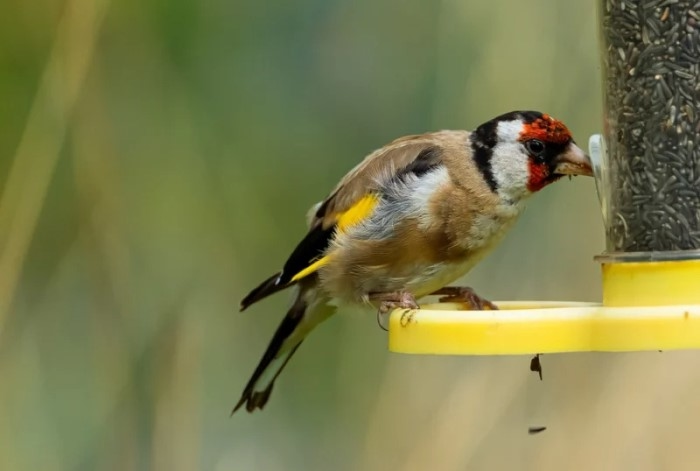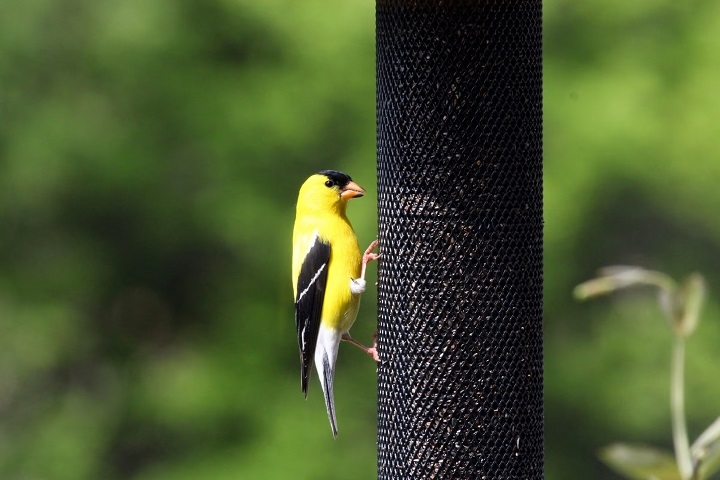Nyjer seed, also known as thistle seed, is a tiny black seed that’s packed with oil and nutrients. It may not look like much, but for many backyard birds, nyjer seed is a delicious and energy-rich treat. If you’re filling a feeder and wondering what birds eat nyjer seed, you’ll be happy to know that this specialty seed attracts a colorful variety of small, active, and beautiful birds—especially finches.
Let’s explore which bird species are drawn to nyjer seed, why they love it, and how to offer it properly for the best birdwatching results.
What Is Nyjer Seed?
Nyjer (pronounced nye-jer) seed is the dried seed of the Guizotia abyssinica plant, native to Africa and Asia. Although it’s often called “thistle seed,” it’s not related to common thistle plants. The seeds are heat-treated before export to prevent germination and are safe to use in feeders without worrying about unwanted weeds.
Why Birds Love Nyjer
- High oil content – Provides energy for small, active birds
- Small and lightweight – Easy for tiny beaks to crack open
- Sterile and clean – Doesn’t sprout in your yard
- Low mess – Often consumed quickly with minimal waste
Nyjer seed is especially valuable during cold months and migration periods when birds need extra calories.
Birds That Eat Nyjer Seed

Nyjer seed primarily attracts finches and other small songbirds. These species have thin, pointed beaks ideal for cracking open the small seeds.
Most Common Nyjer Seed Eaters
American Goldfinch
These bright yellow birds are perhaps the most famous nyjer lovers. They often appear in flocks and will cling to feeders for long periods.
Pine Siskin
Pine siskins are small, streaky finches with a preference for nyjer. They are particularly drawn to feeders in the winter months.
House Finch
House finches enjoy a variety of seeds but often frequent nyjer feeders, especially when competition for food is high.
Purple Finch
Similar to house finches but more vibrant, purple finches also appreciate nyjer as part of their seed-based diet.
Common Redpoll
These tiny northern finches migrate south during cold seasons and are big fans of nyjer seed.
Lesser Goldfinch
Found in the western and southern United States, these colorful finches are known to gather around nyjer feeders in large groups.
European Goldfinch (in Europe and parts of Asia)
Known for their red faces and melodic songs, European goldfinches are also nyjer fans.
Occasionally Seen at Nyjer Feeders
- Indigo Bunting – Occasionally stops by in some regions
- Dark-eyed Junco – May sample nyjer in winter months
- Chickadees and Titmice – Usually prefer sunflower seeds but may try nyjer
While not all birds eat nyjer, the ones that do tend to return often and feed in flocks.
Best Types of Feeders for Nyjer Seed
Nyjer seed is tiny and lightweight, so it requires special feeders that prevent waste and keep the seed dry.
Ideal Feeder Types
Tube Feeders with Small Ports
These feeders are designed with narrow holes that allow only small birds to extract the seed.
Sock Feeders
Made from mesh or nylon, sock feeders let birds cling and peck through the fabric. They’re inexpensive and easy to hang.
Mesh Feeders
Durable metal mesh feeders allow for multiple birds to feed at once and are less prone to tearing than socks.
To reduce seed waste, avoid using open platform feeders where wind or rain can spoil the seed.
When to Offer Nyjer Seed
While nyjer seed is great year-round, there are certain times when birds will especially benefit from it.
- Late summer through winter – Finches molt and need extra energy
- During migration – Provides a high-energy snack for traveling birds
- In colder climates – Helps birds maintain body heat
- In seed-scarce seasons – Offers food when natural sources are low
Refilling your nyjer feeder consistently will help attract loyal visitors throughout the year.
How to Keep Nyjer Seed Fresh
Because nyjer seed has a high oil content, it can go rancid quickly if not stored or maintained properly.
Tips for Freshness
- Store in a cool, dry place away from sunlight
- Only fill feeders with small amounts to avoid spoilage
- Clean feeders regularly to prevent mold or clumping
- Replace seed every few weeks, especially in warm or wet weather
Fresh seed smells slightly nutty. If it smells musty or sour, it’s time to replace it.
Attracting More Finches to Your Yard
Want to increase finch traffic to your feeder? Here are a few extra tips:
- Place feeders near shrubs or trees for cover
- Offer fresh water in a shallow birdbath
- Keep feeders clean and regularly refilled
- Use multiple feeders to accommodate more birds
- Avoid mixing nyjer with other seeds—many birds won’t sift through for it
Consistency and a bird-friendly space are key to attracting and keeping finch visitors.
FAQs About Birds That Eat Nyjer Seed
What birds are most attracted to nyjer seed?
Finches like goldfinches, pine siskins, redpolls, and house finches are the most common nyjer seed eaters.
Can I put any seed in a regular feeder?
No. Nyjer seeds are too small for regular feeders. Use tube feeders with small ports or sock feeders specifically designed for nyjer.
Why aren’t birds eating my nyjer seed?
The seed may be stale, the feeder may be dirty, or it could be the wrong season. Try offering fresh seed and placing the feeder in a quiet, safe spot.
Is nyjer seed safe for all birds?
Yes, but only small songbirds typically eat it. Larger birds and many seed-eating birds prefer sunflower or mixed seed blends.
How long does nyjer seed last?
Stored properly, unopened nyjer seed can last up to a year. Once opened, it’s best used within a few months to retain freshness.



